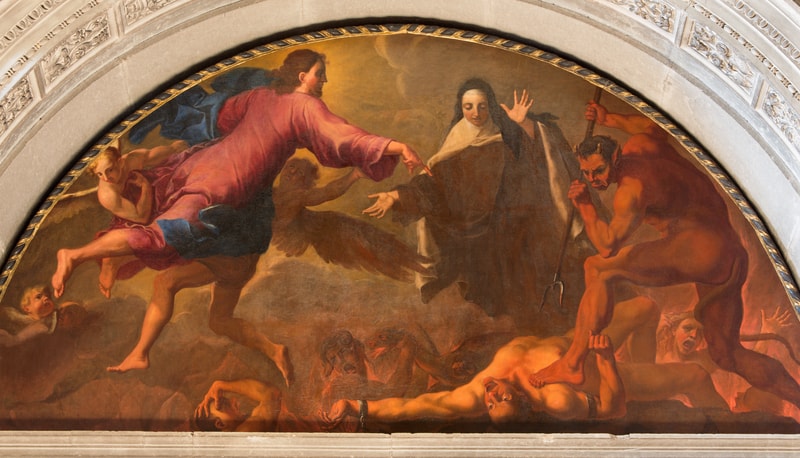Since the earliest days of the church, Christians have believed in a literal hell, a place of torment where unbelievers will spend eternity. Over the centuries, different teachings about hell have emerged.
Some Christian traditions suggest that hell is temporary, others teach that the pain is more metaphorical than literal. And a small minority even suggest that hell does not exist, but that the wicked will be annihilated upon death. But what does Scripture actually say about hell?
The Bible teaches that hell is real. Both the Old and New Testaments depict hell as the final destination of the condemned, completely removed from God’s presence. Scripture does not suggest that hell is either temporary or strictly symbolic.
Hell in the Old Testament

Much of the modern debate over the Christian doctrine of hell begins with our understanding of the Hebrew word Sheol, used throughout the Old Testament. Rich in meaning, Sheol appears over 60 times in the Hebrew Scriptures and has been translated as hell, grave, pit, and depths. The King James Bible renders Sheol as ‘grave’ and ‘hell’ in approximately equal proportion.
Comparing these uses side-by-side, the translators appear to draw a distinction between describing a physical grave (For in death there is no remembrance of thee: in the grave who shall give thee thanks? – Psalm 6:5 KJV), and an abstract or spiritual state of existence (The sorrows of hell compassed me about: the snares of death prevented me. – Psalm 18:5 KJV).
Newer English translations, however, make less frequent use of ‘hell’ as a direct translation of Sheol, instead opting for phrases such as ‘realm of the dead’ or ‘the depths’. Other translations have simply co-opted Sheol into English, as the New King James does with Psalm 16:10 (For You will not leave my soul in Sheol…).
Afterlife and Judgment
Of course, part of the challenge with translating Sheol is that its use to describe both the physical resting place of the dead and the abstract concept of existence after death leaves its very meaning subject to a range of interpretations.
Job speaks of Sheol as a place of isolation, almost a void. Genesis, on the other hand, only uses Sheol to describe a physical grave. While the psalmists associate Sheol at times with suffering, silence, and being completely forgotten.
The clearest depiction of Sheol that we glean from a single Old Testament passage is found in Ezekiel 32. In verses 17-32, the Lord pronounces judgment on various nations who had used the sword against Israel and condemns them to Sheol because of their deeds. However, absent from these verses is a depiction of fire, brimstone, and torment.
Instead, Ezekiel paints a picture of complete separation. The notion that this separation is the result of judgment, and not just a quality of the afterlife as a whole, gives us a reason to see even in the sparse Old Testament witness to the afterlife, different fates for the godly and the wicked. By the time of Jesus, this picture will become even clearer.
Hell in the New Testament
In Hades, where he was in torment, he looked up and saw Abraham far away, with Lazarus by his side. So he called to him, ‘Father Abraham, have pity on me and send Lazarus to dip the tip of his finger in water and cool my tongue, because I am in agony in this fire.’ – Luke 16:23-24
The New Testament greatly increases our understanding of hell. Jesus, in particular, offers descriptions of hell that are not found in the Old Testament, including fire and torment. But before we get to the details, let’s spend some time with the two words that the New Testament translates as hell.
Why Two Words?
Though interchangeable in English, the two Greek words for hell that we read in the New Testament had distinct functions in the original text. One spoke of the physical characteristics of hell. The other described hell interchangeably as a resting place for the dead (similar to the Hebrew Sheol), or as the embodiment of the power of sin and evil.
Hades
Appearing eleven times in the New Testament, Hades refers to the destination of the wicked after death. The Greek Septuagint translates the Hebrew Sheol as Hades, as the words serve an almost identical function.
Pronouncing judgment on Capernaum, Jesus declares that it shall be brought down to Hades (Matthew 11:23, Luke 10:15). And in the story of Lazarus and the rich man, which Jesus tells in Luke 16, the rich man spends the afterlife in Hades.
One unique function that the word Hades serves, however, is as a symbol of the power of sin and evil. In Matthew 16:18, Jesus declares that ‘the gates of hell shall not prevail’ against the church. And Paul writes, in 1 Corinthians 15:55 ‘Where, o death is your victory?’
Gehenna
Appearing twelve times in the New Testament, Gehenna is used to evoke the fire and torturous imagery of hell that we have come to associate with it. Jesus’ use of Gehenna was particularly powerful for his listeners since it referred to a nearby place that his audience would have understood easily.
Gehenna, or the Valley of Hinnom, was a small valley outside of Jerusalem that served as a garbage dump. This is where the nearby towns rid themselves of their animal carcasses and human waste. Burning of garbage was customary in ancient Israel (garbage dumps were often called ‘ash heaps’), so they were closely associated with fire as well as decay and foul air.
So putrid air, constant fire, and death form the image that Jesus brings to his listeners’ minds when he warns of the dangers of hell. He further underscores these aspects by describing hell as a place of damnation (Matthew 23:33) with a fire that cannot be quenched (Mark 9:43) and worms that never die (Mark 9:48).
Total Separation from God
‘And besides all this, between us and you a great chasm has been set in place, so that those who want to go from here to you cannot, nor can anyone cross over from there to us.’ – Luke 16:26
In addition to the torment associated with decay and fire, scripture also describes hell as a state of complete separation from God. The rich man in Jesus’ story finds an unbreachable chasm between himself and Lazarus, who spends the afterlife in rest and comfort. The isolation and darkness of the Hebrew Sheol evoke a similar idea.
Even Jesus’ choice to illustrate hell by likening it to the nearby Gehenna suggests that to be sent to hell is to be cast out from God’s presence (Jerusalem), never to return.
Jesus’ teachings about the final judgment also depict a casting out. ‘Depart from me’ are the words of the Judge pronouncing a final sentence on those who do not know Him (Matthew 7:23). And Revelation 20:11-15 adds that all whose names are not found in the Book of Life, whether living until judgment or presently in hell, are cast out into the lake of fire.
Conclusion
All good things come from God. So complete separation from Him can only result in a complete absence of all that is good. Whether the flames of hell are literal or describe the self-torture of an unquenchable burning desire for God’s presence, we can be certain that hell is a bleak existence far more agonizing than any pain that this life offers. The words of scripture are clear, and it is essential that we take them seriously.





